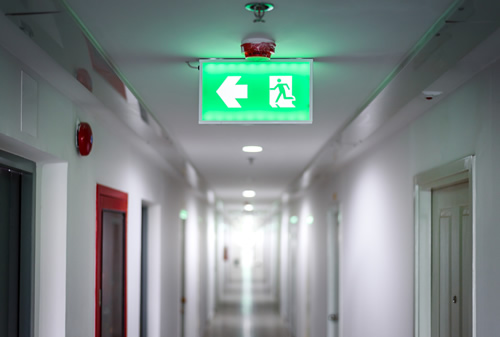Fire Safety – Campus Safety

Going to college is an exciting time for students and their parents. Living in a new “home away from home” not only gives young adults more freedom to make their own choices, but it also provides them an increased level of personal responsibility while at school. When it comes to on- and off-campus housing, it’s important for students and parents to keep fire safety top of mind.
Campus Fire Safety Tips: Download Printable PDF
Fire Safety Checklist: Download Printable PDF
Facts
- Fires in dormitories are more common during the evening hours, between 5–11 pm, and on weekends.
- Roughly six out of seven fires in dormitories are started by cooking.
Safety Tips
- Look for fully sprinklered housing when choosing a dorm or off-campus housing.
Smoke Alarms
- Make sure you can hear the building alarm system when you are in your dorm room.
- If you live in a dormitory, make sure your sleeping room has a smoke alarm, or your dormitory suite has a smoke alarm in each living area as well as the sleeping room. For the best
protection, all smoke alarms in the dormitory suite should be interconnected so that when one sounds, they all sound. - If you live in an apartment or house, make sure smoke alarms are installed in each sleeping room, outside every sleeping area, and on each level of the apartment unit or house. For the best
protection, all smoke alarms in the apartment unit or house should be interconnected so that when one sounds, they all sound. - Test all smoke alarms at least monthly.
- Never remove batteries or disable the alarm.
- When the smoke alarm or fire alarm sounds, get out of the building quickly and stay out.
Escape/Evacuation Plan
- Learn your building’s evacuation plan and practice all drills as if they were the real thing.
- If you live off-campus, have a fire escape plan with two ways out of every room.
Cooking
- When the smoke alarm or fire alarm sounds, get out of the building quickly and stay out.
- Stay in the kitchen or near the source of heat when cooking.
- Cook only when you are alert, not sleepy or drowsy from medicine or alcohol.
- Check with your local fire department for any restrictions before using a barbeque grill, fire pit, or chimenea.
- Check your school’s rules before using electrical appliances in your room
Smoking
- If you smoke, smoke outside and only where it is permitted, Use sturdy, deep, non-tip ashtrays. Don’t smoke in bed or when you’ve been drinking or are drowsy.
It’s a fact, there’s not a lot of space in your dorm room or apartment but that doesn’t mean you should store your bikes, suitcases, etc. in halls and stairwells – and especially NOT in front of exit doors. You need these areas free and clear so you can make a fast escape in case of a fire. If stuff is blocking your exits, you could easily get trapped inside the burning building.
Candles are one of the leading causes of fire in both on- and off-campus housing and because of this, most colleges and universities won’t allow them in dorms. If you want to use candles off-campus try flameless candles. They are inexpensive and come in many shapes and colors. Buy them online or at your nearest home or pharmacy store.
Campus fire safety by the numbers
- From 2011-2015, U.S. fire departments responded to an estimated annual average of 4,100 structure fires in dormitories, fraternities, sororities, and other related properties. These fires caused annual averages of 35 civilian injuries and $14 million in direct property damage.*
- September and October were the peak months for fires in dormitory properties, and they are more common during the evening hours between 5 p.m. and 9 p.m.*
- Cooking equipment was involved in nearly nine out of ten reported fires in dormitory-type properties (87%).*
- From 2000 – present, 92 fatal fires have been documented that occurred on a college campus, in Greek housing or in off-campus housing within 3-miles of the campus – claiming a total of 132 victims**:
- 79 fires have occurred in off-campus housing claiming 113 victims
- 7 fires have occurred in on-campus building or residence halls claiming 9 victims
- 6 fires have occurred in Greek housing claiming 10 victims
- Of the 92 documented**:
- 14 were intentionally set claiming 22 victims
- 38 were accidental – includes cooking, candles, smoking or electrical claiming 51 victims ]
- 40 of the fires the cause was never determined – or the cause was not available at press time. These fires claimed 59 victims.
- From January 2000 – May 2015 smoke alarms were either missing or tampered with (disconnected or the battery removed) in 58 percent of fatal campus fires.***
- 94 percent of fatal campus fires occurred off-campus***
*Source: NFPA’s “Structure Fires in Dormitories, Fraternities, Sororities and Barracks” report
**Source: The Center for Campus Fire Safety
***Source: U.S. Fire Administration
More Resources
- NFPA’s fact sheet on dormitories, fraternities, sororities, and barracks. (PDF)
- Food trucks on campus podcast with NFPA’s Jacqueline Wilmot and Kristin Bigda from Campus Firewatch
- NFPA’s “Structure Fires in Dormitories, Fraternities, Sororities, and Barracks” report
- NFPA Journal® Outreach column: Fire safety Abroad – How college students studying overseas can stay fire safe
- Safety tip sheets, posters, and checklists for students from The Center for Campus Fire Safety
- From the Center for Campus Fire Safety: Parents and Students Checklist: Talking to Landlords about Fire Safety
- From the Center for Campus Fire Safety: Parents and Students Checklist: Talking to School Officials about Fire Safety
References




